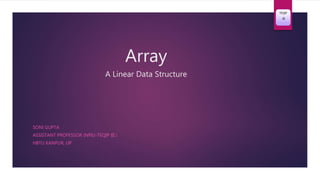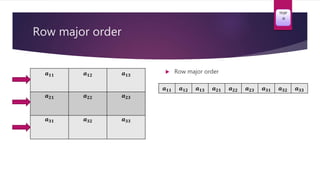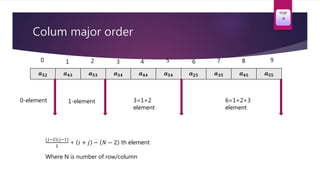Array Data Structures
- 1. Array A Linear Data Structure SONI GUPTA ASSISTANT PROFESSOR (NPIU-TEQIP III ) HBTU KANPUR, UP TEQIP -III
- 2. Topics to be covered ïą What is an array? ïą Declaration of an array ïą Initialization of an array ïą Examples ïą Representation of an array in memory ïą Pointers and array ïą 2-dimensional array ïą Representation in row major order and column major order ïą Example: Representation of Lower triangular matrix ïą Example: Representation of tri diagonal matrix ïą Example: Representation of X-matrix ïą Disadvantage TEQIP -III
- 3. Array ïĩ Array is a collection of similar elements having same data type, accessed using a common name. ïĩ The elements of an array occupy contiguous memory locations. 100 104 108 112 116 120 TEQIP -III
- 4. Dimension of an array: ïĩ In C language there is no limitation on the dimension on an array 1-Dimensional âĒ List âĒ Vector 2-dimensional âĒ Table âĒ Matrix 3-dimensional âĒ 3-d matrix TEQIP -III
- 5. Declaration of an array ïĩ Type-name variable-name [size]; ïĩ The array is indexed from 0 to size-1 ïĩ The size (in brackets) must be an integer literal or a constant variable.) ïĩ Based on the size declared the compiler determine how much space to allocate in memory. TEQIP -III
- 6. Examples: ïĩ int list[5]; // an array of 5 integers list list[0]=4, list[1]=6, list[2]=1, list[4]=50 ïĩ char name[5]; // an array of 5 characters name TEQIP -III 4 6 1 100 50 a i o u e
- 7. ïĩ int table[2][3]; // a two dimensional array of integers table table[0][0]=5, table[0][1]=9, table[1][2]=5, ïĩ Int location[5][5][10]: // a three dimensional array of integer ïĩ Int *a[4] // an array of pointer/address ïĩ a 5 9 14 1 3 5 1004 1008 1120 1222 TEQIP -III
- 8. Initializing an Array ïĩ int list[5]={1,2,5,6,1}; ïĩ char [20]={a,r,w,q,q,t}; // all uninitialized values will set to zero. ïĩ int table[2][3]={{2,3,8}{3,4,9}}; ïĩ int count[ 100 ] = { 1, 2, 3, [10] = 10, 11, 12, [60] = 50, [42] = 500 }; TEQIP -III
- 9. Representation of an array in memory 0 1000 (Base address) 1 1004 2 1008 3 1012 4 1016 IndexValues Address (in Byte) 4 6 1 100 50 TEQIP -III
- 10. Pointers and Array ïĩ An array variable is actually a pointer which hold the address of the first element of the array. ïĩ We can access array value by array notations or pointer value. ïĩ a[0]=*a ïĩ a[1]=*(a+1) ïĩ a[2]=*(a+2) TEQIP -III
- 11. ïĩ a = a+0 = &a[0] ïĩ a+1 = &a[1] ïĩ a+i = &a[i] ïĩ &(*(a+i)) = &a[i] = a+i ïĩ *(&a[i]) = *(a+i) = a[i] ïĩ Address of an element i of array a = a + i * sizeof(element) TEQIP -III
- 12. 2-dimensional Array ïĩ Suppose a 2-d array A[i][j]; ïĩ Row major order Location of A[i][j] = A + ( Number of rows * i + j )*sizeof(element) ïĩ For Column Major Order Location of A[i][j] = A + ( Number of Columns * j + i )*sizeof(element) ïĩ A[i][j]= *(*(A + i) + j)= *(A[i] + j) = (*(A+i))[j] ïĩ &A[i][j]= *(A + i) + j = A[i] + j TEQIP -III
- 13. Row major order ïĩ Row major orderð ðð ð ðð ð ðð ð ðð ð ðð ð ðð ð ðð ð ðð ð ðð ð ðð ð ðð ð ðð ð ðð ð ðð ð ðð ð ðð ð ðð ð ðð TEQIP -III TEQIP -III
- 14. Row major order ï for (i=1,i<=3,i++) ï for (j=1,j<=3,j++) ï { ï Printf(âEnter the elementâ); ï Scanf(â%dâ,A[i][j]); ï } TEQIP -III
- 15. Column major order ïĩ Column major order ð ðð ð ðð ð ðð ð ðð ð ðð ð ðð ð ðð ð ðð ð ðð ð ðð ð ðð ð ðð ð ðð ð ðð ð ðð ð ðð ð ðð ð ðð TEQIP -III TEQIP -III
- 16. Column major order ï for (j=1,j<=3,j++) ï for (i=1,i<=3,i++) ï { ï Printf(âEnter the elementâ); ï Scanf(â%dâ,A[i][j]); ï } TEQIP -III
- 17. ïĩ Row major order ï for (i=1,i<=3,i++) ï for (j=1,j<=3,j++) ï { ï Printf(âEnter the elementâ); ï Scanf(â%dâ,A[i][j]); ï } TEQIP -III
- 18. Character Strings as Arrays of Characters ïĩ Strings are stored in an array of character (char) type along with the null terminating character "0" at the end ïĩ char name[ ] = { âI', âN', âD',âI', âA', 'O'}; OR char name[ ] = âINDIA"; '0' is not necessary. C inserts the null character automatically. length of string= 5 size of string=6 TEQIP -III
- 19. Example : Lower Triangular Matrix 0 0 0 0 0 0 0 0 0 ð ðð 0 0 0 ð ðð ð ðð 0 0 ð ðð ð ðð ð ðð 0 ð ðð ð ðð ð ðð ð ðð TEQIP -III
- 21. Column major order ð ðð ð ðð ð ðð ð ðð ð ðð ð ðð ð ðð ð ðð ð ðð ð ðð 0-element 1-element 3=1+2 element 6=1+2+3 element TEQIP -III
- 22. Colum major order ð ðð ð ðð ð ðð ð ðð ð ðð ð ðð ð ðð ð ðð ð ðð ð ðð 0-element 1-element 3=1+2 element 6=1+2+3 element (ðâ2)(ðâ1) 2 + ð + ð â ð â 2 th element Where N is number of row/column 0 2 81 7 93 4 5 6 TEQIP -III
- 24. Row major order ð ðð ð ðð ð ðð ð ðð ð ðð ð ðð ð ðð ð ðð ð ðð ð ðð 1-element 3=1+2 element 6=1+2+3 element (ðâ2)(ðâ1) 2 + ð + ð â ð â 2 th element Where N is number of row/column 0 2 81 7 93 4 5 6 TEQIP -III
- 25. Example: Tri-diagonal matrix ð ðð ð ðð ð 0 ð ðð ð ðð ð ðð 0 0 ð ðð ð ðð ð ðð 0 0 ð ðð ð ðð TEQIP -III
- 26. Row major order ïĩ 0 1 2 3 4 5 6 7 8 9 ð ðð ð ðð ð ðð ð ðð ð ðð ð ðð ð ðð ð ðð ð ðð ð ðð TEQIP -III
- 27. Example: Diagonal Matrix ð ðð ð ð 0 ð ðð ð ð ðð ð ð ðð 0 ð ð ð ðð ð 0 ð ð ðð ð ð ðð 0 ð ðð 0 0 0 ð ðð TEQIP -III
- 28. Example: Diagonal Matrix ð ðð ð ð 0 ð ðð ð ð ðð ð ð ðð 0 ð ð ð ðð ð 0 ð ð ðð ð ð ðð 0 ð ðð 0 0 0 ð ðð TEQIP -III
- 29. Disadvantage ïĩ The number of element must be known in advance. ïĩ Array is static in nature i.e array size is fixed and it is allocated at compile time. The memory which is allocated to array can not be increased or decreased. ïĩ If we will allocate memory more than required then space will be wasted. ïĩ The elements of an array are stored in consecutive memory locations. Therefore insertion and deletion is difficult and time consuming. TEQIP -III
Editor's Notes
- #6: Array variables are declared identically to variables of their data type, except that the variable name is followed by one pair of square [Â ] brackets for each dimension of the array. Space is allocated only once, at the time the array is declared. The array does NOT change sizes later if the variable used to declare it changes.
- #9: We can declare an array as we declare a variable. Simply list the array values in set notation { } after the declaration If an array is to be completely initialized, the dimension of the array is not required. The compiler will automatically size the array to fit the initialized data. If the size of the array is not given, then the largest initialized position determines the size of the array.




![Declaration of an array
ïĩ Type-name variable-name [size];
ïĩ The array is indexed from 0 to size-1
ïĩ The size (in brackets) must be an integer literal or a constant variable.)
ïĩ Based on the size declared the compiler determine how much space to allocate in
memory.
TEQIP
-III](https://image.slidesharecdn.com/lec23-arraypart1part2-200714181633/85/Array-Data-Structures-5-320.jpg)
![Examples:
ïĩ int list[5]; // an array of 5 integers
list
list[0]=4, list[1]=6, list[2]=1, list[4]=50
ïĩ char name[5]; // an array of 5 characters
name
TEQIP
-III
4 6 1 100 50
a i o u e](https://image.slidesharecdn.com/lec23-arraypart1part2-200714181633/85/Array-Data-Structures-6-320.jpg)
![ïĩ int table[2][3]; // a two dimensional array of integers
table
table[0][0]=5, table[0][1]=9, table[1][2]=5,
ïĩ Int location[5][5][10]: // a three dimensional array of integer
ïĩ Int *a[4] // an array of pointer/address
ïĩ a
5 9 14
1 3 5
1004 1008 1120 1222
TEQIP
-III](https://image.slidesharecdn.com/lec23-arraypart1part2-200714181633/85/Array-Data-Structures-7-320.jpg)
![Initializing an Array
ïĩ int list[5]={1,2,5,6,1};
ïĩ char [20]={a,r,w,q,q,t}; // all uninitialized values will set to zero.
ïĩ int table[2][3]={{2,3,8}{3,4,9}};
ïĩ int count[ 100 ] = { 1, 2, 3, [10] = 10, 11, 12, [60] = 50, [42] = 500 };
TEQIP
-III](https://image.slidesharecdn.com/lec23-arraypart1part2-200714181633/85/Array-Data-Structures-8-320.jpg)

![Pointers and Array
ïĩ An array variable is actually a pointer which hold the address of the first element
of the array.
ïĩ We can access array value by array notations or pointer value.
ïĩ a[0]=*a
ïĩ a[1]=*(a+1)
ïĩ a[2]=*(a+2)
TEQIP
-III](https://image.slidesharecdn.com/lec23-arraypart1part2-200714181633/85/Array-Data-Structures-10-320.jpg)
![ïĩ a = a+0 = &a[0]
ïĩ a+1 = &a[1]
ïĩ a+i = &a[i]
ïĩ &(*(a+i)) = &a[i] = a+i
ïĩ *(&a[i]) = *(a+i) = a[i]
ïĩ Address of an element i of array a = a + i * sizeof(element)
TEQIP
-III](https://image.slidesharecdn.com/lec23-arraypart1part2-200714181633/85/Array-Data-Structures-11-320.jpg)
![2-dimensional Array
ïĩ Suppose a 2-d array A[i][j];
ïĩ Row major order
Location of A[i][j] = A + ( Number of rows * i + j )*sizeof(element)
ïĩ For Column Major Order
Location of A[i][j] = A + ( Number of Columns * j + i )*sizeof(element)
ïĩ A[i][j]= *(*(A + i) + j)= *(A[i] + j) = (*(A+i))[j]
ïĩ &A[i][j]= *(A + i) + j = A[i] + j
TEQIP
-III](https://image.slidesharecdn.com/lec23-arraypart1part2-200714181633/85/Array-Data-Structures-12-320.jpg)

![Row major order
ï for (i=1,i<=3,i++)
ï for (j=1,j<=3,j++)
ï {
ï Printf(âEnter the elementâ);
ï Scanf(â%dâ,A[i][j]);
ï }
TEQIP
-III](https://image.slidesharecdn.com/lec23-arraypart1part2-200714181633/85/Array-Data-Structures-14-320.jpg)

![Column major order
ï for (j=1,j<=3,j++)
ï for (i=1,i<=3,i++)
ï {
ï Printf(âEnter the elementâ);
ï Scanf(â%dâ,A[i][j]);
ï }
TEQIP
-III](https://image.slidesharecdn.com/lec23-arraypart1part2-200714181633/85/Array-Data-Structures-16-320.jpg)
![ïĩ Row major order
ï for (i=1,i<=3,i++)
ï for (j=1,j<=3,j++)
ï {
ï Printf(âEnter the elementâ);
ï Scanf(â%dâ,A[i][j]);
ï }
TEQIP
-III](https://image.slidesharecdn.com/lec23-arraypart1part2-200714181633/85/Array-Data-Structures-17-320.jpg)
![Character Strings as Arrays of Characters
ïĩ Strings are stored in an array of character (char) type along with the null
terminating character "0" at the end
ïĩ char name[ ] = { âI', âN', âD',âI', âA', 'O'};
OR char name[ ] = âINDIA";
'0' is not necessary. C inserts the null character automatically.
length of string= 5
size of string=6
TEQIP
-III](https://image.slidesharecdn.com/lec23-arraypart1part2-200714181633/85/Array-Data-Structures-18-320.jpg)










